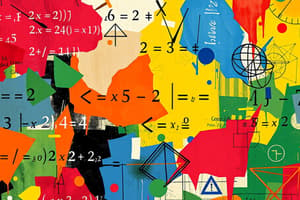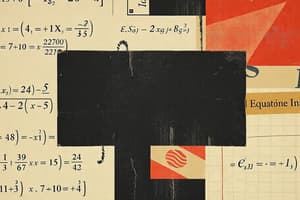Podcast
Questions and Answers
Which of the following concepts are typically included in a foundational Mathematics I course?
Which of the following concepts are typically included in a foundational Mathematics I course?
- Algebra, Geometry, and Trigonometry (correct)
- Calculus and Differential Equations
- Statistics and Probability
- Data Analysis and Visualization
What is included in the study of functions in Algebra?
What is included in the study of functions in Algebra?
- Evaluating functions and graphing functions (correct)
- Differentiating functions
- Identifying prime numbers
- Finding common factors
Which type of geometric shape is NOT considered a fundamental figure in geometry?
Which type of geometric shape is NOT considered a fundamental figure in geometry?
- Circle
- Triangle
- Quadrilateral
- Ellipsoid (correct)
What mathematical concepts does the study of perimeter and area involve?
What mathematical concepts does the study of perimeter and area involve?
Which trigonometric function is defined as the ratio of the opposite side to the hypotenuse in a right triangle?
Which trigonometric function is defined as the ratio of the opposite side to the hypotenuse in a right triangle?
What is the first step when using problem-solving strategies in mathematics?
What is the first step when using problem-solving strategies in mathematics?
In the context of algebra, what does solving inequalities involve?
In the context of algebra, what does solving inequalities involve?
Which of the following involves calculating the volume of a three-dimensional shape?
Which of the following involves calculating the volume of a three-dimensional shape?
Flashcards
Mathematics I
Mathematics I
A foundational mathematics course covering core concepts in algebra, geometry, and trigonometry. It emphasizes problem-solving and analytical reasoning.
Basic Operations in Algebra
Basic Operations in Algebra
Using addition, subtraction, multiplication, and division with variables and numbers in expressions.
Solving Equations and Inequalities
Solving Equations and Inequalities
Finding the value of an unknown variable in an equation or inequality. Includes linear, quadratic, and systems of equations.
Function in Algebra
Function in Algebra
Signup and view all the flashcards
Basic Shapes in Geometry
Basic Shapes in Geometry
Signup and view all the flashcards
Trigonometry
Trigonometry
Signup and view all the flashcards
Formulating Equations
Formulating Equations
Signup and view all the flashcards
Problem-Solving Using Equations
Problem-Solving Using Equations
Signup and view all the flashcards
Study Notes
Introduction to Mathematics I
- Mathematics I is a foundational course covering fundamental mathematical concepts and principles.
- It typically focuses on core topics like algebra, geometry, and trigonometry.
- The course often emphasizes problem-solving skills and analytical reasoning.
Algebra
- Basic Operations: Focuses on arithmetic operations (addition, subtraction, multiplication, division) applied to algebraic expressions.
- Equations and Inequalities: Covers solving linear equations, quadratic equations, systems of equations, and inequalities.
- Functions: Introduces the concept of functions, domain, range, evaluating functions, graphing functions, and identifying types of functions (linear, quadratic, polynomial).
- Polynomials: Discusses operations on polynomials (addition, subtraction, multiplication, division) and factoring polynomials.
- Rational Expressions: Covers operations on rational expressions and equations.
Geometry
- Basic Shapes: Introduces fundamental geometric figures such as points, lines, angles, triangles, quadrilaterals, and circles.
- Properties of Shapes: Discusses properties of different shapes, including angles, sides, and area.
- Constructions: May include geometric constructions using compass and straightedge.
- Coordinate Geometry: Covers plotting points on a coordinate plane, finding distances between points, and graphing lines.
- Perimeter and Area: Calculating perimeter and area of various two-dimensional shapes.
- Volume and Surface Area: Calculating volume and surface area of three-dimensional shapes.
Trigonometry
- Angles and Measurement: Covers the measurement of angles in degrees and radians, and different types of angles.
- Trigonometric Functions: Introduces sine, cosine, and tangent functions and their relationships to angles and sides of right-angled triangles.
- Applications of Trigonometry: Covers problem-solving applications such as finding missing sides and angles in right-angled triangles, solving oblique triangles (non-right-angled triangles), and real-world problems.
- Inverse Trigonometric Functions: Discusses inverse trigonometric functions and their applications.
Problem-Solving Strategies
- Identifying Key Information: Learning to extract crucial details from word problems.
- Formulating Equations: Writing equations that represent a given problem situation.
- Applying Concepts: Using appropriate mathematical concepts to solve problems.
- Checking Solutions: Validating the correctness of the found solutions.
Additional Topics (Potentially Covered)
- Systems of Linear Equations: Focuses on solving systems of linear equations in two or three variables using various methods.
- Matrices: Introduction to matrix operations and applications.
- Vectors: Introduction to vector concepts.
Note Regarding Structure and Depth
- The depth and specific topics covered in a "Mathematics I" course can vary depending on the curriculum and level.
- The structure outlined above provides a general framework. The order and emphasis on these topics can differ in specific course formats.
Studying That Suits You
Use AI to generate personalized quizzes and flashcards to suit your learning preferences.
Description
This quiz covers essential algebraic concepts from Introduction to Mathematics I, focusing on operations, equations, functions, polynomials, and rational expressions. Test your knowledge on solving equations and understanding functions, including their domain, range, and graphing techniques.




